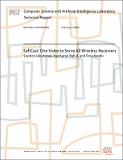SoftCast: One Video to Serve All Wireless Receivers
Author(s)
Katabi, Dina; Rahul, Hariharan; Jakubczak, Szymon
DownloadMIT-CSAIL-TR-2009-005.pdf (1.446Mb)
Additional downloads
Other Contributors
Networks & Mobile Systems
Advisor
Dina Katabi
Metadata
Show full item recordAbstract
The main challenge in wireless video multicast is to scalably serve multiple receivers who have different channel characteristics. Current wireless transmission schemes, however, cannot support smooth degradation. Specifically, each packet is transmitted at a particular bitrate and is decodable only by receivers that support the chosen bitrate. Broadcasting a video stream to all receivers requires transmitting at the lowest bitrate, and hence reduces everyone to the performance of the worst receiver in the multicast group.This paper introduces SoftCast, an alternative design for wireless video multicast, in which a sender broadcasts a single stream and each receiver watches a video quality that matches its channel quality. SoftCast achieves this by making the magnitude of the transmitted signal proportional to the pixel value. Hence, channel noise directly translates to a small perturbation in pixel values, allowing graceful degradation with increasing noise. SoftCast introduces a novel power allocation scheme that allows the transmission of real-valued video signals in a compact and resilient manner. We implement SoftCast in the WARP radio platform. Our results show that SoftCast improves the average video quality across multicast receivers by 3-7dB over the current approach. Further, it stays competitive with the current approach even for regular unicast.
Date issued
2009-02-07Series/Report no.
MIT-CSAIL-TR-2009-005
Keywords
Wireless networks, Multicast, Wireless video, Video coding